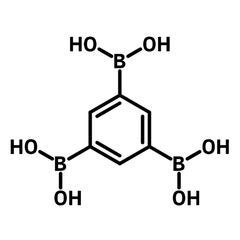Benzene-1,3,5-triyltriboronic acid
CAS Number 89641-21-4
Chemistry Building Blocks, COF Ligands, Materials, MOF Ligands, Porous Organic FrameworksCovalent organic frameworks (COFs) benzenetriboronic acid ligand
used to synthesize COFs and MOFs for applications in sensors and battery cathodes
Specifications | MSDS | Literature and Reviews
Benzene-1,3,5-triyltriboronic acid (CAS number 89641-21-4) is a benzene derivative substituted with three boronic acid groups at the meta-position. Benzene-1,3,5-triyltriboronic acid reacts with various ligands to synthesize COFs. These reactions include dehydration reaction with boronic acids to form boroxine linkers, boronate esterification with diols to produce boronate ester linkers and Suzuki cross-coupling reaction with aryl halides. A conjugated COF, synthesized from benzene-1,3,5-triyltriboronic acid and dibromoanthraquinone, is used for sodium-ion battery cathodes. The resulting material delivers a high capacity of 200 mAh/g and rate performance of 105 mAh/g at 200 °C.
Benzene-1,3,5-triyltriboronic acid also reacts with copper sulfate for a 2D MOF material with well-defined supramolecular structures. The 2D MOF exhibits a conductivity of 0.087 S/cm.
Facile reactions
Readily for boronic acid condensation and Suzuki reaction
High Purity
>98% Purity
Worldwide shipping
Quick and reliable shipping
MOF and COF ligands
Boronic acid ligand for cross-linked COF networks
General Information
| CAS Number | 89641-21-4 |
| Chemical Formula | C6H9B3O6 |
| Full Name | Benzene-1,3,5-triyltriboronic acid |
| Molecular Weight | 209.57 g/mol |
| Synonyms | 1,3,5-benzenetriboronic acid, B,B',B''-1,3,5-benzenetriyltris-boronic acid, BTBA, BTPA |
| Classification / Family | Boronic acids, COFs, MOFs, Conjugated, Sensors, Battery cathodes, Porous materials |
Chemical Structure

Product Details
| Purity | 98% |
| Melting Point | N/A |
| Appearance | White powder |
MSDS Documentation
Benzene-1,3,5-triyltriboronic acid MSDS Sheet
Literature and Reviews
- Highly sensitive and selective fluorescence chemosensors containing phenanthroline moieties for detection of Zn2+ and Cd2+ ions, C. Quan et al., Chem. Pap., 74, 485–497 (2020); DOI: 10.1007/s11696-019-00893-9.
- Electrochemical synthesis of large area two-dimensional metal-organic framework films on copper anodes, Y. Liu et al., Angew. Chem. Int. Ed., 60 (6), 2887–2891 (2021); DOI: 10.1002/anie.202012971.
- Nanoscale covalent organic frameworks as theranostic platforms for oncotherapy: synthesis, functionalization, and applications, Q. Guan et al., Nanoscale Adv., 2, 3656 (2020); DOI: 10.1039/d0na00537a.
